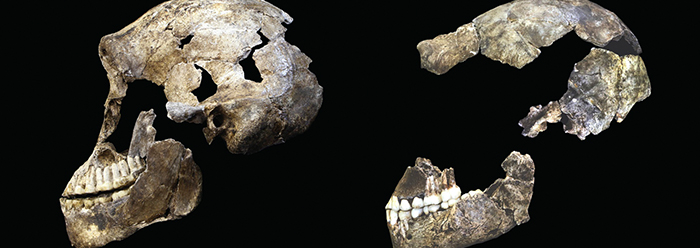Homo naledi, the latest failed candidate for a missing link in human evolution, was deposited in the Rising Star cave system in South Africa. New fossil dating attempts reveal troubling difficulties with science’s attempt at answering historical questions.
The answer to naledi’s timing carries some big implications. If the naledi fossils receive a date of three or so million years, then they could remain in the running for a possible missing link between ancient apes and modern humans. But researchers gave the remains a much more recent age, unseating naledi from any evolutionary hopes. How did they determine an age for the remains or the flowstones discovered around them? After all, it’s not like time is a substance that science can directly probe.
Paul Dirks from Australia’s James Cook University led the study, published in the online technical journal eLife.1 Dirks told LSU’s Media Center, “The dating of naledi was extremely challenging. Eventually, six independent dating methods allowed us to constrain the age of this population of Homo naledi to a period known as the late Middle Pleistocene.”2
Why six methods? If scientists really trust any single method, shouldn’t that one suffice? The need to compare so many different methods on various samples is just the first of many difficulties with scientific attempts to assign ancient dates to objects.
Results from five of those six methods provide enough information to understand the challenge this team faced in assigning an evolutionary-friendly age to these potentially key fossils. They applied radiocarbon (C-14), Electron-Spin Resonance (ESR), uranium-thorium decay (U-Th), and Optically-Stimulated Luminescence (OSL) in a central age statistical model (CAM), and OSL in a minimal age model (MAM) to bones, teeth, and cave flowstones that surrounded the fossils.
Dating methods should reveal their reliability by independently giving very similar ages for the same sample and its surroundings. But these six results landed all over the place, leaving an 800,000 year gap between the youngest and oldest dates.
U-Th on the flowstone FS1b showed an age of about 290,000 uranium years, but OSL (CAM) results ranged from 546,000 to 560,000 years. OSL (MAM) on flowstone FS1a showed 353,000 years, but OSL (CAM) gave approximately 849,000!1 Will the real flowstone age please stand up?
ESR results from one tooth ranged from 87,000 to 104,000 years, but the U-Th method on the same sample showed only 43,500 to 46,100 years. Similarly, ESR from another tooth yielded 230,000 to 284,000, whereas U-Th results for the same sample ranged 66,200 to 146,800 years. Last, C-14 results for associated bones ranged from 33,000 to about 35,500 carbon years.
How did Dirks’ team determine that the H. naledi bones were deposited between 236,000 to 335,000 years from this wide-ranging age collection?
Actually, discordant age-dates like these typify attempts to use natural processes like decaying radioactive elements or erosion as clocks. Very often, researchers can select from a range of options.3 And when they do, they commonly explain away those results they choose to reject.4 That’s not science; it’s cherry picking. It’s more like blind guesswork with evolutionary time driving date selection—they look at all the data and essentially select the ones that fit what they are looking for. This Homo naledi paper was no exception.
The naledi dating team chose the older tooth results, from ESR, and the U-Th ages from certain flowstones. They did not even explain why they rejected the U-Th result from three different Homo naledi teeth, which ranged from 43,500 to 146,000 years.
The team also rejected all the data taken directly from the actual bones they were trying to date. At least they offered some reasoning when they cited contamination from calcite precipitation as affecting the C-14 results. But what direct observation of contamination led them to this speculation? They gave none.
Without a truly objective way to select from their options, a strong possibility emerges—perhaps none come anywhere close to the fossil’s actual age.
In the end, it looks like these researchers rejected all the younger ages in favor of the oldest results. But the new age determination still lands nowhere near the three million years that Homo naledi needs to satisfy the evolutionary model. But at least an age of 236,000 to 335,000 years doesn’t sound too embarrassing for evolution—they’re only off by a factor of ten.5
References
- Dirks, P.H.G.M. et al. 2017. The age of Homo naledi and associated sediments in the Rising Star Cave, South Africa. eLife. 6:e24231.
- New Research Shows Early Ancestor May Have Coincided with Modern Humans. LSU Media Center. Posted on lsu.edu May 9, 2017, accessed May 26, 2017.
- Woodmorappe, J. 1979. Radiometric Geochronology Reappraised. Creation Research Society Quarterly. 16 (2): 102-129.
- Woodmorappe, J. 1999. The Mythology of Modern Dating Methods. Santee, CA: Institute for Creation Research.
- Anatomically modern human remains already occur in Middle Pleistocene sediments, which in a biblical timeline were deposited during the post-Flood Ice Age, showing that naledi did not predate, and thus did not evolve into, modern man.
*Mr. Thomas is Science Writer at the Institute for Creation Research.
Article posted on June 8, 2017.














